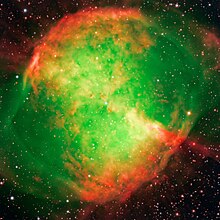Vulpecula
| Constellation | |
55th) | |
| Main stars | 5, 20 |
|---|---|
| Bayer/Flamsteed stars | 33 |
| Stars with planets | 5 |
| Stars brighter than 3.00m | 0 |
| Stars within 10.00 pc (32.62 ly) | 0 |
| Brightest star | α Vul (Anser) (4.44m) |
| Messier objects | 1 |
| Bordering constellations | Cygnus Lyra Hercules Sagitta Delphinus Pegasus |
| Visible at latitudes between +90° and −55°. Best visible at 21:00 (9 p.m.) during the month of September. | |
Vulpecula /vʌlˈpɛkjʊlə/ is a faint constellation in the northern sky. Its name is Latin for "little fox", although it is commonly known simply as the fox. It was identified in the seventeenth century, and is located in the middle of the Summer Triangle (an asterism consisting of the bright stars Deneb, Vega, and Altair).
Features

Stars
There are no stars brighter than 4th magnitude in this constellation. The brightest star in Vulpecula is Alpha Vulpeculae, a magnitude 4.44m[1] red giant[2][3] at an approximate distance of 291 light-years. The star is an optical binary (separation of 413.7") that can be split using binoculars. The star also carries the traditional name Anser, which refers to the goose the little fox holds in its jaws.[4]
23 Vulpeculae is the second brightest star in the constellation.
In 1967, the first
Vulpecula is also home to HD 189733 b, one of the closest extrasolar planets studied by the now-retired Spitzer Space Telescope. On 11 July 2007, a team led by Giovanna Tinetti published the results of their observations using the Spitzer Space Telescope concluding there is solid evidence for significant amounts of water vapor in the planet's atmosphere.[7] Although HD 189733b with atmospheric temperatures rising above 1,000 °C is far from being habitable, this finding increases the likelihood that water, an essential component of life, would be found on a more Earth-like planet in the future.
Also located in Vulpecula is soft gamma repeater SGR 1935+2154. In 2020 it emitted a fast radio burst, the first one to be observed in the Milky Way.[8][9][10][11]
Deep-sky objects

The

The eastern part of Vulpecula is occupied by the Hercules–Corona Borealis Great Wall. It is a galaxy filament, with the length of 3,000 megaparsecs, making it the largest structure in the universe.
Stellar association
Vulpecula contains an OB-association of young stars, called the Vulpecula OB-association or Vul OB1. The association contains nearly 100 OB-stars and over 800 young stellar objects. It lies in the galactic plane, at a distance of about 2300 parsec. It contains the emission-line nebulae Sh-86, Sh-87 and Sh-88. Vul OB1 has a length of about 100 parsec and is sculpting many pillar-like structures in this region.[16][17]
History

In the late 17th century, the astronomer Johannes Hevelius created Vulpecula. It was originally known as Vulpecula cum ansere ("the little fox with the goose") or Vulpecula et Anser ("the little fox and the goose"), and was illustrated with a goose in the jaws of a fox. Hevelius did not regard the fox and the goose to be two separate constellations, but later the stars were divided into a separate Anser and Vulpecula. Today, they have been merged again under the name of the fox, but the goose is remembered by the name of the star α Vulpeculae: Anser.
See also
- 3C 433
- Vulpecula (Chinese astronomy)
References
Sources
- Ridpath, Ian; Tirion, Wil (2017). Stars and Planets Guide (5th ed.). London: William Collins. ISBN 978-0-691-17788-5.
Footnotes
- Bibcode:1986EgUBV........0M.
- .
- S2CID 209140544.
- ISBN 978-3-319-22794-8.
- S2CID 4277613.
- S2CID 4247734.
- ^ "Press Release: NASA's Spitzer Finds Water Vapor on Hot, Alien Planet". Archived from the original on 2007-07-15. Retrieved 2007-07-11.
- ^ Hall, Shannon (11 June 2020). "A Surprise Discovery Points to the Source of Fast Radio Bursts - After a burst lit up their telescope "like a Christmas tree," astronomers were able to finally track down the source of these cosmic oddities". Quantum Magazine. Retrieved 11 June 2020.
- ^ Timmer, John (4 November 2020). "We finally know what has been making fast radio bursts - Magnetars, a type of neutron star, can produce the previously enigmatic bursts". Ars Technica. Retrieved 4 November 2020.
- ^ Cofield, Calla; Andreoli, Calire; Reddy, Francis (4 November 2020). "NASA Missions Help Pinpoint the Source of a Unique X-ray, Radio Burst". NASA. Retrieved 4 November 2020.
- S2CID 218763435. Retrieved 5 November 2020.
- NASA.gov. Retrieved 2018-07-17.
- ^ a b
O'Dell, C. R.; Balick, B.; Hajian, A. R.; Henney, W. J.; et al. (2002). "Knots in Nearby Planetary Nebulae". doi:10.1086/340726.
- ^ "The icy blue wings of Hen 2-437". Retrieved 8 February 2016.
- ISBN 978-1-55407-175-3.
- ^ "Ass Vul OB 1". simbad.cds.unistra.fr. Retrieved 2023-05-14.
- S2CID 28961682.
External links
- The Deep Photographic Guide to the Constellations: Vulpecula
- Vulpecula page at SEDS (Students for the Exploration and Development of Space)
- M-27 page at SEDS
- Star Tales - Vulpecula
